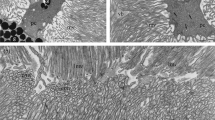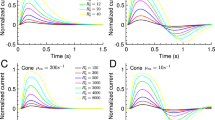Abstract
The light-induced membrane voltage response (receptor potential, ReP) and the absorption change of the intracellularly injected calcium indicator arsenazo III (arsenazo response) were recorded simultaneously in Limulus ventral nerve photoreceptor cells. A double pulse technique was applied for stimulation. After pressure injection of the indicator into the cell absorption changes were measured at 646 nm to obtain a measure of the changes of the intracellular calcium ion concentration.
-
1.
The size of the arsenazo response increases with increasing intensity of the light stimulus. The intensity dependence of the size of the arsenazo response δAmax shows almost no correlate with the peak amplitude of the ReP, but correlates rather well with the time integral of the ReP.
-
2.
Decreasing light adaptation (caused by prolongation of the repetition time of the pulse pairs) leads to an increase in size of the arsenazo response. Also here δAmax correlates better with the time integral of the ReP than with its peak amplitude.
-
3.
Lowering the calcium concentration in the superfusate (from 10 mmol/l to ca. 40 Μmol/l) causes after ca. 10 min a drastical diminution of the arsenazo response to values below the noise level, and a less marked reduction in size of the ReP. The falling phase of the ReP is slower. After return to normal calcium concentration the arsenazo response recovers partly in ca. 50 min, while the ReP recovers faster.
The results show two opposite correlations between ReP and arsenazo response:
Increase in size and duration of the ReP causes a greater transient increase of the intracellular calcium ion concentration. This in turn tends to reduce and shorten the ReP. Which effect dominates obviously depends on the conditions of the experiment: when the calcium concentration in the superfusate is reduced to ca. 40 Μmol/l a slow decrease of the ReP is accompanied by a small increase of the intracellular calcium ion concentration.
Similar content being viewed by others
References
Ahmed Z, Connor JA (1979) Measurement of calcium influx under voltage clamp in molluscan neurones using the metallochromic dye arsenazo III. J Physiol Lond 286:61–82
Baker PF, Glitsch HG (1975) Voltage dependent changes in the permeability of nerve membranes to calcium and other divalent cations. Phil Trans R Soc Lond B 270:389–409
Brown JE, Blinks JR (1974) Changes in intracellular free calcium concentration during illumination of invertebrate photoreceptors. Detection with aequorin. J Gen Physiol 64:643–665
Brown JE, Brown PK, Pinto LH (1977) Detection of light-induced changes of intracellular ionized calcium concentration in Limulus ventral nerve photoreceptors using arsenazo III. J Physiol 267:299–320
Brown JE, Cohen LB, de Weer P, Pinto LH, Ross WN, Salzberg BM (1975) Rapid changes of intracellular free calcium concentration. Detection by metallochromic indicator dyes in squid giant axon. Biophys J 15:1155–1160
Fein A, Charlton JS (1977) A quantitative comparison of the effects of intracellular calcium injection and light adaptation on the photoresponse of Limulus ventral photoreceptors. J Gen Physiol 70:591–600
Kendrick NC (1976) Purification of arsenazo III, a Ca++-sensitive dye. Anal Biochem 76:487–501
Lisman JE, Brown JE (1972) The effects of intracellular iontophoretic injections of calcium and sodium ions on the light response of Limulus ventral photoreceptors. J Gen Physiol 59:701–719
Lisman JE, Brown JE (1975a) Light-induced changes of sensitivity in Limulus ventral photoreceptors. J Gen Physiol 66:473–488
Lisman JE, Brown JE (1975b) Effects of intracellular injections of calcium buffers on light adaptation in Limulus ventral photoreceptors. J Gen Physiol 66:489–506
Maaz G (1978) Thesis. Rheinisch-WestfÄlische Technische Hochschule Aachen
Maaz G, Nagy K, Stieve H, Klomfa\ J (1980) In preparation
Meech RW (1978) Personal communication
Meech RW, Mack Brown H (1976) Invertebrate photoreceptors: A survey of recent experiments on photoreceptors from Balanus and Limulus. Perspectives in experimental biology, Vol 1: Zoology. In: Davies P (ed) Pergamon Press, London, pp 331–351
Millecchia R, Mauro A (1969) The ventral photoreceptor cells of Limulus. II. The basic photoresponse. J Gen Physiol 54:310–330
Mullins LJ (1977) A mechanism for Na/Ca transport. J Gen Physiol 70:681–695
Scarpa A, Brinley FJ, Tiffert T, Dubyak GR (1978) Metallochromic indicators of ionized calcium. Ann NY Acad Sci 307:86–112
Author information
Authors and Affiliations
Rights and permissions
About this article
Cite this article
Maaz, G., Stieve, H. The correlation of the receptor potential with the light induced transient increase in intracellular calcium-concentration measured by absorption change of arsenazo III injected into Limulus ventral nerve photoreceptor cell. Biophys. Struct. Mechanism 6, 191–208 (1980). https://doi.org/10.1007/BF00537293
Received:
Accepted:
Issue Date:
DOI: https://doi.org/10.1007/BF00537293




